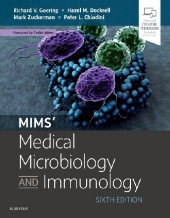 Neuerscheinungen 2018Stand: 2020-02-01 |
Schnellsuche
ISBN/Stichwort/Autor
|
Herderstraße 10
10625 Berlin
Tel.: 030 315 714 16
Fax 030 315 714 14
info@buchspektrum.de |

Peter L. Chiodini, Hazel M. Dockrell, Richard V. Goering, Mark Zuckerman
(Beteiligte)
Mims´ Medical Microbiology and Immunology
Enhanced Digital Version
Mitarbeit: Goering, Richard V.; Dockrell, Hazel M.; Zuckerman, Mark; Chiodini, Peter L.
6. Aufl. 2018. 568 S. Approx. 1496 illustrations (1496 in full color). 276 mm
Verlag/Jahr: ELSEVIER 2018
ISBN: 0-7020-7154-4 (0702071544)
Neue ISBN: 978-0-7020-7154-6 (9780702071546)
Preis und Lieferzeit: Bitte klicken
Learn all the microbiology and basic immunology concepts you need to know for your courses and exams. Now fully revised and updated, Mims´ clinically relevant, systems-based approach and abundant colour illustrations make this complex subject easy to understand and remember.
Learn about infections in the context of major body systems and understand why these are environments in which microbes can establish themselves, flourish, and give rise to pathologic changes. This systems-based approach to microbiology employs integrated and case-based teaching that places the ´bug parade´ into a clinical context.
Effectively review for problem-based courses with the help of chapter introductions and ´Lessons in Microbiology´ text boxes that highlight the clinical relevance of the material, offer easy access to key concepts, and provide valuable review tools.
Approach microbiology by body system or by pathogen through the accompanying electronic ´Pathogen Parade´ - a quickly searchable, cross-referenced glossary of viruses, bacteria and fungi
A new electronic ´Vaccine Parade´ offers quick-reference coverage of the most commonly used vaccines in current clinical practice
Deepen your understanding of epidemiology and the important role it plays in providing evidence-based identification of key risk factors for disease and targets for preventative medicine.
Grasp and retain vital concepts easily, with a user-friendly colour coded format, succinct text, key concept boxes, and dynamic illustrations.
New and enhanced information reflects the growing importance of the human microbiota and latest molecular approaches
Access the complete contents on the go via the accompanying interactive eBook, with a range of bonus materials to enhance learning and retention - includes self-assessment materials and clinical cases to check your understanding and aid exam preparation.
SECTION 1 THE ADVERSARIES - PATHOGENS
1. Pathogens as parasites
2. The bacteria
3. The viruses
4. The fungi
5. The protozoa
6. The helminths
7. The arthropods
8. Prions
9. The host-parasite relationship
SECTION 2 THE ADVERSARIES - HOST DEFENCES
10.The innate defences of the body
11. Adaptive immune responses bring specificity
12. Cooperation leads to effective immune responses
SECTION 3 THE CONFLICTS
13. Background to the infectious diseases
14. Entry, exit and transmission
15. Immune defences in action
16. Spread and replication
17. Parasite survival strategies and persistent infections
18. Pathological consequences of infection
SECTION 4 CLINICAL MANIFESTATION AND DIAGNOSIS OF INFECTIONS BY BODY SYSTEM
The clinical manifestations of infection
19. Upper respiratory tract infections
20. Lower respiratory tract infections
21. Urinary tract infections
22. Sexually transmitted infections
23. Gastrointestinal tract infections
24. Obstetric and perinatal infections
25. Central nervous system infections
26. Infections of the eye
27. Infections of the skin, soft tissue, muscle and associated systems
28. Vector-borne infections
29. Multisystem zoonoses
30. Fever of unknown origin
31. Infections in the compromised host
SECTION 5 DIAGNOSIS AND CONTROL
32. Diagnosis of infection and assessment of host defence mechanisms
33. Epidemiology and control of infectious diseases
34. Attacking the enemy: antimicrobial agents and chemotherapy
35. Protecting the host: vaccination
36. Active, passive and adoptive immunotherapy
37. Infection control


